The Bond Vigilantes are back. They were last active during the 1980s and early 1990s. They've been mostly lying low since then. That's partly because inflation remained remarkably subdued from the mid-1990s through 2020. Furthermore, in response to the Great Financial Crisis and then the Great Virus Crisis, central banks kept the Bond Vigilantes in check with ZIRP, NIRP, and QE. [1]
No more: They're back in the saddle again and riding high. Excessively stimulative fiscal and monetary policies in response to the pandemic were promoted by Modern Monetary Theorists and implemented by governments around the world. Inflation came roaring back in 2021 and 2022 forcing central banks to tighten their monetary policies, while fiscal policies continued to run amok.
Once the central banks were forced to stop their Great Financial Repression, the bond vigilantes were set loose.
On Friday, the new British government announced massive deficit-financed tax cuts. To counter the inflationary consequences, and stop the pound's free fall, the BOE may have to tighten even more. The 10-year UK bond yield rose over 4.00% today. On Friday morning, it was under 3.50%.
Bond yields jumped around the world. Here in the US, the Fed turned more hawkish last week about the outlook for the federal funds rate at the same time as it has started to implement a program of quantitative tightening. That combination may turn out to be too restrictive.
[1] ZIRP is zero-interest-rate policies. NIRP is negative-interest-rate policies, and QE is quantitative easing.



